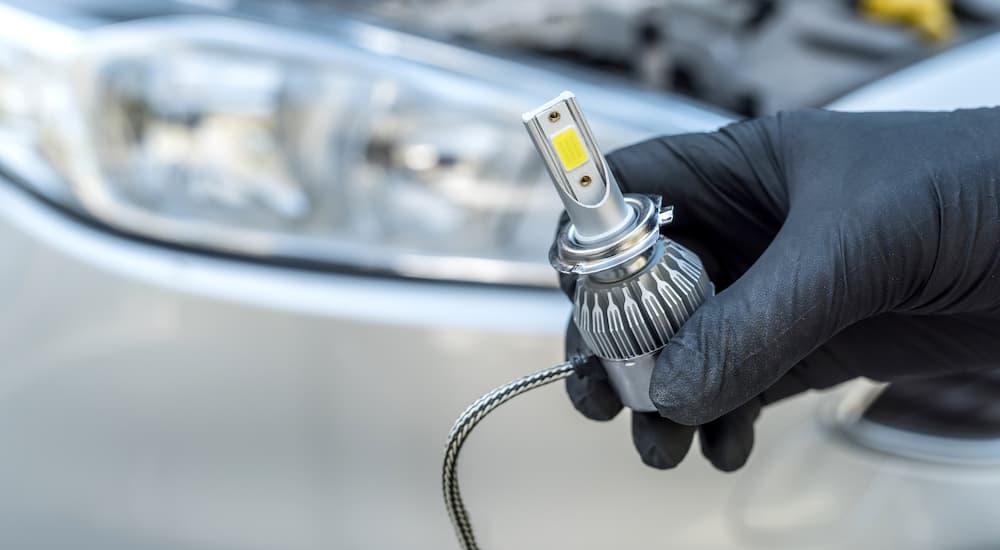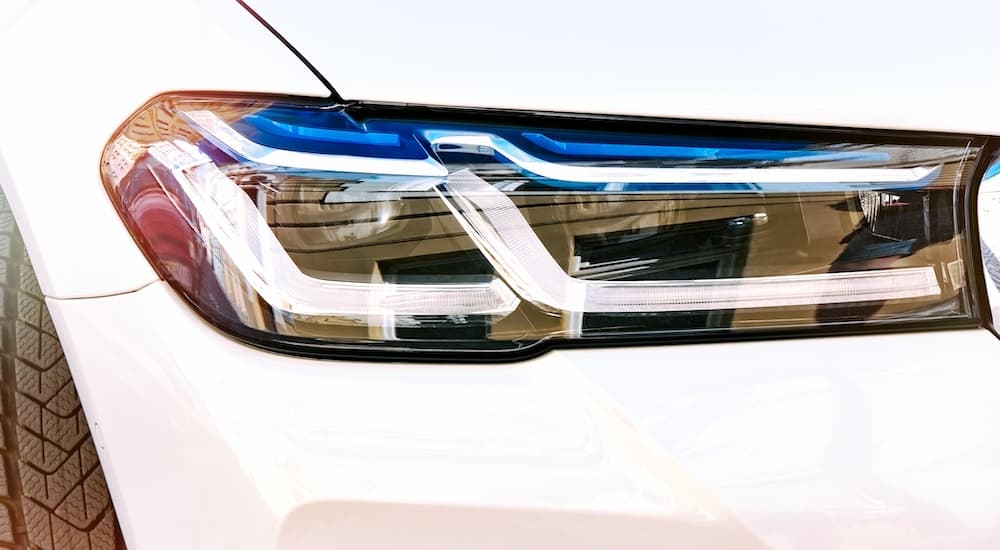Of all the safety equipment packed into modern vehicles, headlights might be the most important. It’s hard to underestimate the impact that a good set of headlights can have on the overall driving experience. Headlights have come a long way from the kerosene oil lamps that graced some of the earliest cars and have made leaps and bounds in recent years with the introduction of new LED, xenon, and laser options. These next-generation headlights have quickly become the new norm in the market, with Consumer Reports estimating that 86 percent of 2019 models were sold with LED lights––up from 55 percent in 2018. What are the differences between the old-fashioned halogen bulbs we grew up with and these newer designs? Are they worth the price, and how difficult are they to install? We’ll cover all that and more as we take a closer look at the four most popular types of vehicle headlights, so read on if you’re seeking a little illumination.
Halogen Headlights
The go-to choice for decades, halogen headlights are now losing ground to newer, higher-tech options like LED and HID headlights. These incandescent bulbs work on the same principle as most old-fashioned light bulbs: a tungsten filament is stretched between two points in a glass bulb filled with halogen, argon, and other gasses. When electricity runs through the filament, it heats up and produces a warm, yellow-ish light, which is then either projected onto the road (in the case of projector-style headlights) or reflected off mirrored surfaces within the headlight assembly (in reflector-style headlights).
While they can’t match the illuminating power of some newer headlight styles, halogen bulbs’ real advantage comes from their cost and availability. As the most common bulb on the market today, halogen bulbs can be found for as little as $10 per set. They’re also very easy to replace as they require no special tools and can be switched out in a matter of minutes. That said, you’ll probably find yourself replacing them more often than any other type of headlight. Halogen bulbs are usually only rated to last between 500 and 1,000 hours, so you’ll have no shortage of opportunities to practice the replacement process.
The biggest downside of halogen bulbs is their lack of range, which can be less than a third of what LED and HID lamps can achieve. They are also one of the least efficient bulbs on the market, which can be taxing on a vehicle’s electrical system and increase fuel consumption, especially when compared to LED headlights. Halogen bulbs are also sensitive to contaminants, requiring an extra level of care when it comes to installation. For example, the oils on your fingertips can cause uneven heat distribution on the bulb and lead to a shorter lifespan as the bulb develops a hot spot.
LED Headlights
Light-Emitting Diode (LED) lights are all the rage as of late, with the term splashed all over the marketing material of every new model to hit the streets. Unlike halogen bulbs, which use a form of incandescent light, LED bulbs rely on a principle known as electroluminescence. In basic terms, an LED is a semiconductor that transforms electricity into light. The go-to choice for many of today’s consumer electronics, LEDs are popular for their extraordinary efficiency. LEDs are also very small compared to halogen bulbs, allowing automakers to pack them closer together and leaving more room in the headlight assembly for turn signals and other components. They can also be designed to emit nearly any color on the spectrum, allowing drivers to choose a hue that best fits their own vision and preference (within legal limits).
While LED lights draw much less energy than halogen options, they do produce a significant amount of heat which can affect other parts of the headlight assembly. For this reason, LED headlight assemblies are designed with a heat sink that helps to keep everything cool. LED headlight assemblies are also much more expensive than old-school halogen designs, often costing hundreds of dollars to replace. That said, they also last a heck of a lot longer, meaning less time spent replacing burnt-out bulbs and more time behind the wheel. Factory LED lights are generally designed to last for the life of the vehicle, and aftermarket LEDs can last for tens of thousands of hours. They also have a much longer range, making nighttime driving less stressful. With so many advantages, it’s easy to see why LED lights have quickly gobbled up market share, though the replacement cost can still be a drawback for some drivers.

HID Headlights
Xenon headlights, also known as high-intensity discharge (HID) lights, might not have the market share of halogen or LED bulbs, but they’re commonly found on higher-end vehicles. HID lights are notable for the very bright bluish-white light they produce, which is a result of the xenon and argon gasses used in their construction. Instead of using a filament like halogen bulbs, HID lights employ high-pressure xenon, which, when stimulated by the bulb’s high-voltage electrodes, is superheated into its plasma state.
These lights are not only some of the brightest on the market, illuminating the road two to three times better than standard halogen bulbs, but they’re also far more efficient, producing less heat than halogen or LED bulbs. HID headlights have been on the market since 1991 when they debuted on the BMW 7 Series, but they never achieved the widespread popularity of LED headlights. They’re notable for their longevity when compared to halogen bulbs, with the lack of a delicate filament leading to an average lifespan of more than 3,000 hours, but there are some drawbacks.
First off, there’s the expense. Thanks to the rare earth metal and gas used in their construction, HID bulbs tend to be quite expensive when compared to halogen options. Sure, they might last three times longer, but with a set of bulbs costing as much as $100, it’s not always the bargain it might seem. HID lights also take a little longer to warm up than some other types of bulbs, requiring a little patience on the driver’s part. Lastly, HID bulbs can work a little too well, producing an extremely bright light that can blind other drivers on the road. For this reason, aftermarket HID kits are illegal in some states, so you should check your local laws before making the upgrade.
Laser Headlights
The new kid on the block, laser headlights represent a giant leap in automotive headlight technology. Contrary to what the sci-fi-worthy name might have you think, laser headlights don’t project actual lasers onto the road ahead but rather rely on a complex chemical reaction known as chemiluminescence. In laser headlights, several small lasers stimulate a lens filled with phosphorus gas, creating an ultra-bright light that bounces off specialized reflectors and onto the road. Thanks to this unique design, there’s no danger of laser light escaping the headlight assembly, though most manufacturers have built-in a failsafe that disables the lights in the event of a front-end collision.
Laser headlights have been on the market for over a decade but are rarely found outside of established luxury brands like BMW, Audi, and the like. This is largely due to their cost, which is by far the highest on the market at several hundred dollars per set of bulbs. So far, this cost has seen laser headlights limited to high-end models like the BMW i8 and the Audi R8 LMX, where the surcharge for laser headlights represents a smaller portion of the vehicle’s overall cost. American laws also made it difficult to obtain laser headlights for much of the past ten years, but Congress recently approved the technology with the passage of the 2021 bipartisan infrastructure bill.
Laser headlights are extremely bright, producing significantly more light than LED or HID options while consuming much less energy. Laser headlights are also much smaller than the already-small LED lights, allowing manufacturers to build even smaller, sleeker headlight assemblies. That said, laser headlights come with some obvious downsides. Expense is the most obvious, with a new set of laser headlight assemblies costing as much as the typical used car. This cost is largely due to the advanced technology used in their construction and will likely fall as the technology comes into its own, but as of now, they’re not too practical outside of the upper end of the market. They can also only be used for high-beam applications, meaning that every set of laser headlights will need to include some LED or HID bulbs to provide low-beam illumination.

Are You Ready for a Headlight Overhaul?
For drivers looking to upgrade their headlight game, there are plenty of choices on the market today. While there’s nothing wrong with a set of good, old-fashioned halogen bulbs, LED and HID options make a compelling case for a headlight overhaul, offering drastically improved visibility and efficiency while giving vehicles a more modern look. That said, it can be expensive, with LED and HID bulbs adding hundreds or even thousands to the overall cost of operation. If you’re thinking about switching up your headlights, it’s also important to consider the type of driving you’ll be doing.
While bright LED and HID headlights might make a big difference for those who engage in a lot of nighttime driving on secluded rural roads, they won’t have nearly the same impact in urban or suburban environments. Also, be sure to check the laws in your area regarding the use of aftermarket lighting kits, as they’re still restricted in some areas. Most importantly, consider the impact on other drivers because while brighter lights can improve overall driver safety, they can come at the cost of visibility for other drivers on the road. No matter what route you choose, a new set of headlights is always a good way to brighten your future.

